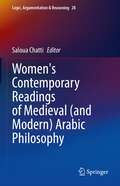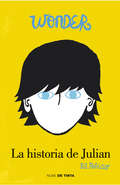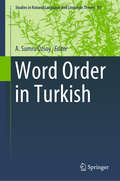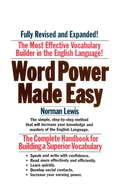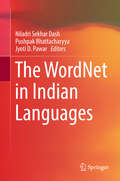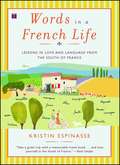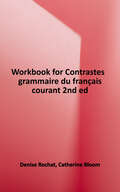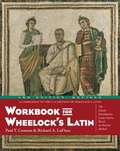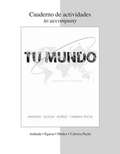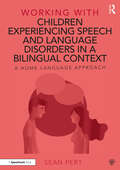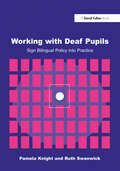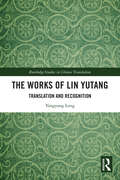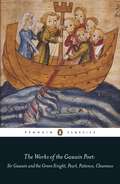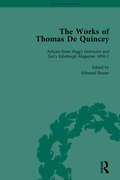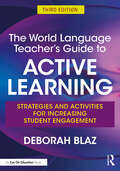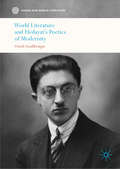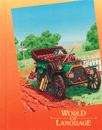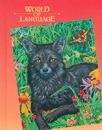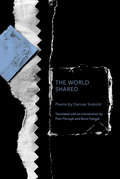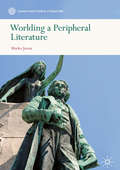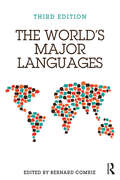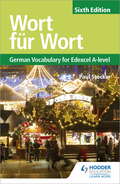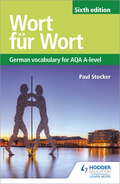- Table View
- List View
Women's Contemporary Readings of Medieval (Logic, Argumentation & Reasoning #28)
by Saloua ChattiThis book explores a large variety of topics involved in Arabic philosophy. It examines concepts and issues relating to logic and mathematics, as well as metaphysics, ethics and aesthetics. These topics are all studied by different Arabic philosophers and scientists from different periods ranging from the 9th century to the 20th century, and are representative of the Arabic tradition. This is the first book dealing with the Arabic thought and philosophy and written only by women. The book brings together the work and contributions of an international group of female scholars and researchers specialized in the history of Arabic logic, philosophy and mathematics. Although all authors are women, the book does not enter into any kind of feminist trend. It simply highlights the contributions of female scholars in order to make them available to the large community of researchers interested in Arabic philosophy and to bring to the fore the presence and representativeness of female scholars in the field.
Wonder. La historia de Julian
by R. J. PalacioWonder. La lección de August ha recordado a miles de lectores la importancia de ser amable. Pero este no es un libro sobre August, un niño que quiere ser normal a pesar de su aspecto, sino sobre Julian. ¿Qué motivos tiene Julian para odiar a August?¿Será capaz de asumir sus errores y empezar de nuevo? Wonder. La historia de Julian trata sobre el niño que peor se porta con Auggie. No soporta verlo, no soporta que sea amigo de Jack, no soporta que esté en su colegio... y no es capaz de darse cuenta del impacto que sus actos pueden tener en los demás. Provocadora, sorprendente y emotiva, Wonder. La historia de Julian deleitará a los lectores de Wonder. La lección de August... y a los que todavía no la han leído.
Word Order in Turkish (Studies in Natural Language and Linguistic Theory #97)
by A. Sumru ÖzsoyThis volume is a collection of studies on various aspects of word order variation in Turkish. As a head-final, left-branching ‘free’ word order language, Turkish raises a number of significant theory-internal as well as language-particular questions regarding linearization in language. Each of the contributions in the present volume offers a fresh insight into a number of these questions, thus, while expanding our knowledge of the language-particular properties of the word order phenomena, also contribute individually to the theory of linearization in general. Turkish is a configurational language. It licenses constructions in which constituents can occur in non-canonical presubject as well as postverbal positions. Presented within the assumptions of the generative tradition, the discussion and analyses of the various aspects of the linearization facts of the language offer a novel treatment of the issues therein. The authors approach the word order phenomena from a variety of perspectives, ranging from purely syntactic treatments, to accounts as syntax-PF interface or syntax-discourse interface phenomena or as output of base generation.
Word Power Made Easy: The Complete Handbook for Building a Superior Vocabulary
by Norman LewisThe most effective vocabulary builder in the English language provides a simple, step-by-step method that will increase your knowledge and mastery of written and spoken English. Word Power Made Easy does more than just add words to your vocabulary. It teaches ideas and a method of broadening your knowledge as an integral part of the vocabulary building process. Do you always use the right word? Can you pronounce it--and spell it--correctly? Do you know how to avoid illiterate expressions? Do you speak grammatically, without embarrassing mistakes? If the answer to any of these questions is no, you need Word Power Made Easy. Written in a lively, accessible, and timeless style, and loaded with helpful reviews, progress checks, and quizzes to reinforce the material, this classic resource has helped millions learn to speak and write with confidence.
The WordNet in Indian Languages
by Niladri Sekhar Dash Pushpak Bhattacharyya Jyoti D. PawarThis contributed volume discusses in detail the process of construction of a WordNet of 18 Indian languages, called "Indradhanush" (rainbow) in Hindi. It delves into the major challenges involved in developing a WordNet in a multilingual country like India, where the information spread across the languages needs utmost care in processing, synchronization and representation. The project has emerged from the need of millions of people to have access to relevant content in their native languages, and it provides a common interface for information sharing and reuse across the Indian languages. The chapters discuss important methods and strategies of language computation, language data processing, lexical selection and management, and language-specific synset collection and representation, which are of utmost value for the development of a WordNet in any language. The volume overall gives a clear picture of how WordNet is developed in Indian languages and how this can be utilized in similar projects for other languages. It includes illustrations, tables, flowcharts, and diagrams for easy comprehension. This volume is of interest to researchers working in the areas of language processing, machine translation, word sense disambiguation, culture studies, language corpus generation, language teaching, dictionary compilation, lexicographic queries, cross-lingual knowledge sharing, e-governance, and many other areas of linguistics and language technology.
Words in a French Life
by Kristin EspinasseBased on the popular blog (french-word-a-day.com) and newsletter with thousands of subscribers -- a heart-winning collection from an American woman raising two very French children with her French husband in Provence, carrying on a lifelong love affair with the language. Imagine a former French major getting vocabulary tips from her young children! That was the experience of Kristin Espinasse, an American who fell in love with a Frenchman and moved to his country to marry him and start a family. When her children began learning the language, she found herself falling in love with it all over again. To relate the stories of her sometimes bumpy, often comic, and always poignant assimilation, she created a blog in the tradition of books such as A Year in Provence and Almost French, drawing more admirers than she ever could have imagined. With an approach that is as charming as it is practical, Espinasse shares her story through the everyday French words and phrases that never seem to make it to American classrooms. "Comptoir" ("counter") is a piece about the intricacies of grocery shopping in France, and "Linge" ("laundry") swoons over the wonderful scent the laundry has after being hung out in the French countryside, while "Toquade" ("crush") tells of Espinasse's young son, who begins piling gel onto his hair before school each morning when he becomes smitten with a girl in class. Steeped in French culture but experienced through American eyes, Words in a French Life will delight armchair travelers, Francophiles, and mothers everywhere.
Workbook for Contrastes: Grammaire Du Francais Courant
by Denise RochatThe workbook contains exercises that progress from basic to more advanced; from fill in the blank (with answers provided at the end) to sentence completion, from transformation exercises to compositions, culminating in a few English/French translations for the more advanced level.
Workbook for Wheelock's Latin (3rd edition, revised)
by Paul T. Comeau Richard A. LafleurWorkbook associated with the classic text Wheelock's Latin
Workbook Lab Manual: Tu Mundo Actividades
by Magdalena Andrade Jeanne Egasse Elías Miguel Muñoz María Cabrera-PucheThe Cuaderno de actividades (Workbook/Laboratory Manual) to accompany Tu mundo links culture to the main text and to students' lives.
Working with Children Experiencing Speech and Language Disorders in a Bilingual Context: A Home Language Approach (Working With)
by Sean PertThe complexity of speech and language disorders can be daunting in a monolingual context. When working with a bilingual child assessment and intervention may appear to be even more complicated. In this book Sean Pert provides the reader with the tools needed to overcome this perception and develop skills in working in a language that they don’t share with the client. By adopting a home language first approach the book discusses how to: identify diversity from disorder introduce effective approaches in line with the best clinical practice work successfully alongside interpreters make assessments and plan interventions set goals for therapy. At the heart of the text is the therapist creating essential partnerships with parents and truly valuing the bilingualism, culture and identity of the child. This leads to better outcomes, not only in speech, language and communication, but also in self-esteem, mental health, social participation and educational and employment success. The book concludes with a handy toolkit of resources including quizzes, case studies and printable extras making it the perfect resource for both experienced and newly qualified practitioners with bilingual and multilingual children in their care.
Working with Deaf Children: Sign Bilingual Policy into Practice
by Pamela Knight Ruth SwanwickThis book is essential and accessible reading for all teachers and professionals who are working with sign bilingual deaf children. It considers the background and theory underpinning current developments in sign bilingual education and the implications for policy and developing classroom practice. Practical teaching strategies are suggested and evaluated. The authors draw on their own experience of working in sign bilingual settings as well as current good practice and relevant research. This book is the first UK book that describes sign bilingual education (beyond policy). It is also the first book to support sign bilingual practice dealing with current educational issues. The authors draw together relevant research and practice in sign bilingual education and present practical strategies for teachers.
The Works of Lin Yutang: Translation and Recognition (Routledge Studies in Chinese Translation)
by Yangyang LongThe Works of Lin Yutang is the first book to provide a comprehensive study of Lin Yutang’s translation theory and translated (and written) works in English as a whole, examined from the perspective of his pursuit of recognition of cultural equity between China and the English-speaking world. The arc of the book is Lin’s new method of translating China to the Anglophone world, which is crucial to rendering Chinese culture as an equal member of the modern world. This book identifies Lin’s legacy of translation and recognition as his acknowledgement of source and target cultural territories in translation, and at the same time, his questioning of perspectives that privilege the authority of either. This book will appeal to scholars and students in Translation Studies, World and Comparative Literature, Literary and Cultural Studies, and Chinese Studies. It can also be used as a reference work for practitioners in translation and creative writing.
The Works of the Gawain Poet: Sir Gawain and the Green Knight, Pearl, Cleanness, Patience
by Ad Putter Myra StokesA new volume of the works of the Gawain poet, destined to become the definitive edition for students and scholars.This volume brings together four works of the unknown fourteenth-century poet famous for the Arthurian romance Sir Gawain and the Green Knight, in their original Middle English. In one of the great tales of medieval literature, Gawain, the noblest knight of King Arthur's court, must keep a deadly bargain with a monstrous knight and resist the advances of his host's beautiful wife. The dream vision of Pearl depicts a bereaved father whose lost child leads him to glimpse heaven. And in moral poems based on stories from the Bible, Cleanness warns against sins of the flesh and of desecration, while Patience encourages readers to endure suffering as God's will.Little is known about the so-called 'Gawain poet', who wrote during the late fourteenth century. It is believed that he came from south-east Cheshire, an important cultural and economic centre at the time, and he was clearly well-read in Latin, French and English. Although he is not named as the author of Sir Gawain and the Green Knight, Pearl, Patience, Cleanness, the four works have been attributed to him based on a careful comparison of their language, date and themes.Myra Stokes was formerly Senior Lecturer in the Department of English at Bristol University. Her books include Justice and Mercy in Piers Plowman and The Language of Jane Austen.Ad Putter teaches at the English Department and the Centre for Medieval Studies of the University of Bristol, where is Professor of Medieval English Literature. His monographs include Sir Gawain and the Green Knight and French Arthurian Romance and An Introduction to the Gawain Poet, and he is also co-editor of The Cambridge Companion to the Arthurian Legend.
The Works of Thomas De Quincey, Part III vol 17
by Grevel Lindop Barry SymondsThomas De Quincey (1785-1859) is considered one of the most important English prose writers of the early-19th century. This is the final part of a 21-volume set presenting De Quincey's work, also including previously unpublished material.
The World Language Teacher's Guide to Active Learning: Strategies and Activities for Increasing Student Engagement
by Deborah BlazEnhance your students’ success and improve the likelihood of retention with the easy-to-implement activities and strategies in this book! Bestselling author Deborah Blaz shows how to create a classroom in which students can actively experience and explore a world language. The new edition features updates in every chapter and incorporates the latest ACTFL standards, more information on teaching with authentic resources, a new chapter on teaching with technology, and additional resources for personalized learning. It is organized to allow you to easily find and pull activities you want to use in your classroom the very next day. You’ll learn how to… mix up your repertoire of activities, games, and exercises to keep students engaged; introduce students to the culture of the language you teach by hosting parties and celebrations; overcome some of the biggest obstacles in the path to fluency, including verb conjugation, using object pronouns, and the subjunctive mood; customize your teaching strategies to accommodate a broader range of talents, skills, and intelligences; implement new assessment strategies to improve verbal skills and reading comprehension; and more! Bonus: Downloadable versions of some of the resources in this book are available on the Routledge website at www.routledge.com/9781032258294 so you can print and distribute them for immediate classroom use.
World Literature and Hedayat’s Poetics of Modernity (Canon and World Literature)
by Omid AzadibougarThis book introduces the canonical figure Sadegh Hedayat (1903–1951) and draws a comprehensive image of a major intellectual force in the context of both modern Persian Literature and World Literature. A prolific writer known for his magnum opus, The Blind Owl (1936), Hedayat established the use of common language for literary purposes, opened new horizons on imaginative literature and explored a variety of genres in his creative career. This book looks beyond the reductive critical tendencies that read a rich and diverse literary profile in light of Hedayat’s suicide, arguing instead that his literary imagination was not solely the result of genius but rather enriched by a vast network of the world’s literary traditions. This study reflects on Hedayat’s attempts at various genres of artistic creation, including painting, fiction writing, satire and scholarly research, as well as his persistent struggles for artistic authenticity, which transcended solidly established literary and artistic norms. Providing a critical reading of Hedayat’s work to untangle aspects of his writing – including reflections on science, religion, nationalism and coloniality – alongside his pioneering work on folk culture, and how humor informs his writings, this text offers a critical review of the status of Persian literature in the contemporary landscape of the world’s literary studies.
World Of Language
by Sandra Breuer Judy Brim Wendy DavisThe book that unlocks all imagination opening every mind to new and exciting ideas. World of language is a literature book that indeed enlarges your world to think, read, speak, listen and write.
World of Language
by Marian Davies Toth Nancy Nickell Ragno Betty G. GrayThis text contains unit lessons on Using Language to narrate; to inform; to imagine; to persuade; to describe; to research; to create; and to classify.
The World Shared (Lannan Translations Selection Series)
by Dariusz SosnickiDariusz Sosnicki's poems open our eyes to the sublime just beneath the surface of the mundane: a train carrying children away from their parents for summer vacation turns into a ravenous monster; a meal at a Chinese restaurant inspires a surreal journey through the zodiac; a malfunctioning printer is a reminder of the ghosts that haunt us no matter where we find ourselves.Among the perpetrators and victims,buzzed or wasted to the bone,gliding without their blinkers onin the ruts of the national fate—they're not at home.Dariusz Sosnicki is an award-winning poet, essayist, and editor in Poland.
Worlding a Peripheral Literature (Canon and World Literature)
by Marko JuvanBringing together the analyses of the literary world-system, translation studies, and the research of European cultural nationalism, this book contests the view that texts can be attributed global importance irrespective of their origin, language, and position in the international book market. Focusing on Slovenian literature, almost unknown to world literature studies, this book addresses world literature’s canonical function in the nineteenth-century process of establishing European letters as national literatures. Aware of their dependence on imperial powers, (semi)peripheral national movements sought international recognition through, among other things, the newly invented figure of the national poet. Writers central to dependent national communities were canonized to represent their respective cultures to the norm-giving Other – the emerging world literary canon and its aesthetic ideology. Hence, national literatures asserted their linguo-cultural individuality through the process of worlding; that is, by their positioning in the international literary world informed by the supposed universality of the aesthetic.
The World's Major Languages
by Bernard ComrieThe World's Major Languages features over 50 of the world's languages and language families. This revised edition includes updated bibliographies for each chapter and up-to-date census figures. The featured languages have been chosen based on the number of speakers, their role as official languages and their cultural and historical importance. Each language is looked at in depth, and the chapters provide information on both grammatical features and on salient features of the language's history and cultural role. The World’s Major Languages is an accessible and essential reference work for linguists.
Wort für Wort Sixth Edition: German Vocabulary for Edexcel A-level
by Paul StockerExam board: EdexcelLevel: A-levelSubject: GermanFirst teaching: September 2016First exams: Summer 2017Essential vocabulary for Edexcel A level German, all in one place.- Supplement key resources such as course textbooks with all the vocab students need to know in one easy-to-navigate place, completed updated to match the latest specification - Ensure extensive vocab coverage with topic-by-topic lists of key words and phrases, including a new section dedicated to film and literature - Test students' knowledge with end-of-topic activities designed to deepen their understanding of word patterns and relationships - Develop effective strategies for learning new vocab and dealing with unfamiliar words
Wort für Wort Sixth Edition: German Vocabulary for AQA A-level
by Paul StockerExam board: AQALevel: A-levelSubject: GeographyFirst teaching: September 2016First exams: Summer 2018Essential vocabulary for AQA A-level German, all in one place.- Supplement key resources such as course textbooks with all the vocab students need to know in one easy-to-navigate place, completed updated to match the latest specification - Ensure extensive vocab coverage with topic-by-topic lists of key words and phrases, including a new section dedicated to film and literature - Test students' knowledge with end-of-topic activities designed to deepen their understanding of word patterns and relationships - Develop effective strategies for learning new vocab and dealing with unfamiliar words
Wort für Wort Sixth Edition: German Vocabulary for AQA A-level
by Paul StockerExam board: AQALevel: A-levelSubject: GeographyFirst teaching: September 2016First exams: Summer 2018Essential vocabulary for AQA A-level German, all in one place.- Supplement key resources such as course textbooks with all the vocab students need to know in one easy-to-navigate place, completed updated to match the latest specification - Ensure extensive vocab coverage with topic-by-topic lists of key words and phrases, including a new section dedicated to film and literature - Test students' knowledge with end-of-topic activities designed to deepen their understanding of word patterns and relationships - Develop effective strategies for learning new vocab and dealing with unfamiliar words
